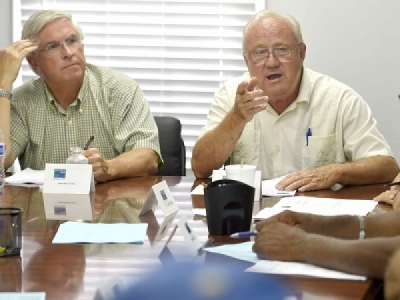
Posted on September 1, 2016
By Steve Hardy, The Advocate
The regional agency in charge of mitigating flood damage around the Amite River met Tuesday for the first time since the river and its tributaries overflowed their banks, wrecking thousands of homes and businesses.
The Amite River Basin Commission’s special meeting was short, intended mostly to sign off on some emergency contracts. Commissioners did not linger on the flood itself or on projects like the incomplete Comite River Diversion Canal — which the commission oversees and which one past commission president has said could have saved a quarter of the flooded homes had it been finished. The commission also oversees smaller projects, such as repairing the weir on the Amite where it forks with its own diversion canal.
The commission is a 13-member board whose members hail from all the parishes in the basin: East Baton Rouge Rouge, East Feliciana, Livingston, St. Helena, Ascension and St. James. It was created following the devastating 1983 flood to oversee projects that would prevent flooding in the region, such as the since-aborted Darlington Reservoir.
Presently, the commission’s efforts are mostly focused on completing the diversion canal, which would redirect water from the Comite and several bayous in East Baton Rouge Parish into the Mississippi River during periods of high water. However, the project has stalled for decades. It relies on the tax-funded commission to purchase land for the canal and to offset the destruction of wetlands, and construction is reliant on state money through the Department of Transportation and Development as well as federal funding via the U.S. Army Corps of Engineers.
The various agencies have blamed one another for the slow progress, especially in the aftermath of the August flood. However, while state and federal representatives attended the Tuesday meeting, they did not spend time pointing fingers.
Executive Director Dietmar Rietschier briefly remarked that the destruction from the recent floods may finally be enough to convince federal agencies to invest in the project.
“I just hope for the best. If this event doesn’t do it, I don’t know what will do it,” he said.
He also cautioned that the flooding was so severe no one project could have completely saved every home.
Most of the meeting was spent discussing efforts to quantify just how destructive the floods were. Engineer and consultant Bob Jacobsen showed the commissioners where survey crews have already taken high-water measurements, often by relying on the debris line from soaked houses.
The meeting was officially called so the board could retroactively approve Rietschier’s decision to hire surveyors to begin measuring the damage. He said he hired the crews without official approval because the damage needed to be measured quickly before people tore out their waterlogged drywall and the evidence disappeared. Waiting to measure, he said, would be like sending a detective to a murder scene two weeks after the body was found.
The commission unanimously approved the work completed so far — about $120,000 — and gave Rietschier a $175,000 ceiling to finish any of that work that still must be completed.
The commission staff would like to take 200 measurements from the Comite to the Colyell and currently have taken about 180. The commission’s data will be shared with numbers collected by the Army Corps of Engineers and the U.S. Geological Survey to map the extent of the flood and the water depth at various locations.
The measurements will be useful for academic purposes, such as improving the flood model, Jacobsen said. It will also have practical use, as people try to figure out how high they need to build.
Source: The Advocate





